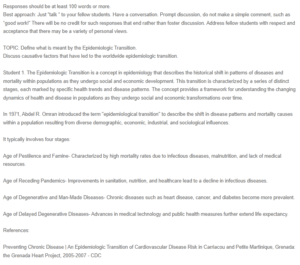Peer Responses – Epidemiologic Transition
Responding to Student 1
Hello,
Great work with your post. You made an interesting point on the epidemiologic transition, providing a comprehensive overview of the four stages. Indeed, Abdel R. Omran’s framework has been crucial in understanding the complex interplay between social and economic development and changes in disease patterns (Montesi & Calestani, 2021). To add to your analysis, it’s worth noting that the epidemiologic transition has been a valuable tool for studying historical shifts. Some scholars argue for an updated perspective to include emerging challenges like antimicrobial resistance and globalization. These factors can influence the dynamics of disease in ways that might not be fully captured by the traditional stages. Furthermore, the global nature of health challenges today emphasizes the importance of collaborative efforts in addressing diseases. The interconnectedness of our world requires a more holistic approach, not only considering the epidemiological aspects but also factors such as socio-economic inequalities. Overall, your post provides a solid foundation for understanding the epidemiologic transition.
References
Montesi, L., & Calestani, M. (Eds.). (2021). Managing chronicity in unequal states: Ethnographic perspectives on caring. UCL Press. http://www.jstor.org/stable/j.ctv1nnwhmv
Responding to Student 2
Hello,
This is a great post. Your perspective on the multifaceted nature of the epidemiologic transition is quite compelling. Not only did you include traditional factors like hygiene and vaccinations, but also the impact of technology on our lifestyles. Indeed, the dual role of technology in facilitating medical advancements while potentially contributing to sedentary behaviors is an important aspect to consider (Ullah et al., 2023). To add to your analysis, the influence of marketing and education in promoting healthier lifestyles is important. However, it is necessary to evaluate the effectiveness of certain drugs. Furthermore, holistic approaches like dietary changes should be explored. Moreover, your mention of documentaries and scientific studies highlighting the societal impacts on health adds depth to the discussion. A nuanced perspective is essential for comprehending epidemiologic transitions. There is a complex connection between lifestyle choices, technology, and healthcare. Recognizing the interplay of these factors sheds light on the complexity of understanding shifts in disease patterns over time.
References
Ullah, M., Hamayun, S., Wahab, A., Khan, S. U., Rehman, M. U., Haq, Z. U., & Naeem, M. (2023). Smart technologies are used as smart tools in managing cardiovascular disease and their future perspective. Current Problems in Cardiology, 48(11), 101922. https://doi.org/10.1016/j.cpcardiol.2023.101922
ORDER A PLAGIARISM-FREE PAPER HERE
We’ll write everything from scratch
Question
Responses should be at least 100 words or more.
Best approach: Just “talk “ to your fellow students. Have a conversation. Prompt discussion, do not make a simple comment, such as “good work!” There will be no credit for such responses that end rather than foster discussion. Address fellow students with respect and acceptance that there may be a variety of personal views.

Peer Responses – Epidemiologic Transition
TOPIC: Define what is meant by the Epidemiologic Transition.
Discuss causative factors that have led to the worldwide epidemiologic transition.
Student 1. The Epidemiologic Transition is a concept in epidemiology that describes the historical shift in patterns of diseases and mortality within populations as they undergo social and economic development. This transition is characterized by a series of distinct stages, each marked by specific health trends and disease patterns. The concept provides a framework for understanding the changing dynamics of health and disease in populations as they undergo social and economic transformations over time.
In 1971, Abdel R. Omran introduced the term “epidemiological transition” to describe the shift in disease patterns and mortality causes within a population resulting from diverse demographic, economic, industrial, and sociological influences.
It typically involves four stages:
Age of Pestilence and Famine- Characterized by high mortality rates due to infectious diseases, malnutrition, and lack of medical resources.
Age of Receding Pandemics- Improvements in sanitation, nutrition, and healthcare lead to a decline in infectious diseases.
Age of Degenerative and Man-Made Diseases- Chronic diseases such as heart disease, cancer, and diabetes become more prevalent.
Age of Delayed Degenerative Diseases- Advances in medical technology and public health measures further extend life expectancy.
References:
Preventing Chronic Disease | An Epidemiologic Transition of Cardiovascular Disease Risk in Carriacou and Petite Martinique, Grenada: the Grenada Heart Project, 2005-2007 – CDC
The Epidemiologic Transition: A Theory of the Epidemiology of Population Change on JSTOR
Epidemiological Transition Model | Stages & Examples – Video & Lesson Transcript | Study.com
Student 2. Epidemiologic transition can be best defined as the transition from infectious, parasitic, and nutritional deficiency diseases to noninfectious chronic diseases. The contributing factors are improved hygiene and sanitation, vaccinations to fight infectious microbes, effective antibiotics to combat parasitic disease, and adequate caloric intake, however, while these are just a few contributing factors, these are also the reasons for “demographic transition” which decreases fertility and increases life expectancy. We currently have a larger geriatric population prone to noncommunicable diseases while the younger population are prone to chronic diseases. (Harris, 2020, pg. 8)
Other factors I would argue into epidemiologic transition is the use of technology and while some of this technology has made medical advancements for the healthcare field, its also another reason humans have become “lazy”, which leads to type 2 diabetes, cardiovascular disease, cancers, and chronic respiratory diseases. Another factor is marketing or promoting a healthier lifestyle, education, and drugs. I would argue whether some of the “drugs” are effective since a change in diet can alter an individual’s cholesterol levels, hence, no use of drugs but better choice of healthy food options.
As we continue to learn and advance in the healthcare field, it’s important to know there’s many documentaries revealing scientific studies and experiments that can back up the epidemiologic transition as well as “do you really know where your food is coming from?”. Some of the factors for this transition are things not only technology has changed but is also the contributing factor to morbidity and mortality.
References
Harris, R. E. (2020). Epidemiology of chronic disease: global perspectives. Burlington, Ma: Jones & Bartlett Learning.

